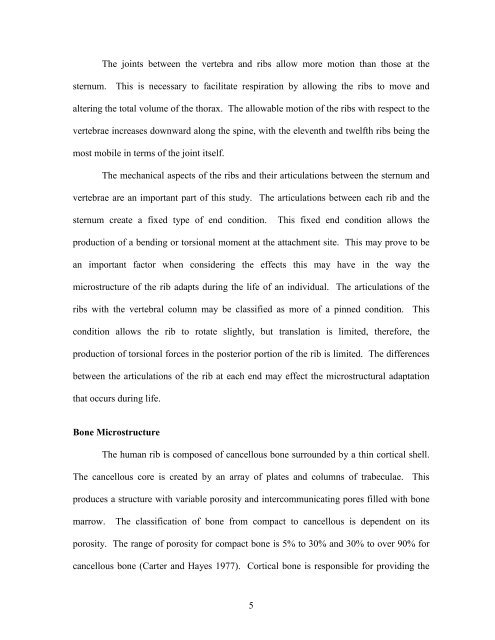Microstructural And Mechanical Properties Of Human Ribs Joseph
Microstructural And Mechanical Properties Of Human Ribs Joseph
Microstructural And Mechanical Properties Of Human Ribs Joseph
You also want an ePaper? Increase the reach of your titles
YUMPU automatically turns print PDFs into web optimized ePapers that Google loves.
The joints between the vertebra and ribs allow more motion than those at the<br />
sternum. This is necessary to facilitate respiration by allowing the ribs to move and<br />
altering the total volume of the thorax. The allowable motion of the ribs with respect to the<br />
vertebrae increases downward along the spine, with the eleventh and twelfth ribs being the<br />
most mobile in terms of the joint itself.<br />
The mechanical aspects of the ribs and their articulations between the sternum and<br />
vertebrae are an important part of this study. The articulations between each rib and the<br />
sternum create a fixed type of end condition. This fixed end condition allows the<br />
production of a bending or torsional moment at the attachment site. This may prove to be<br />
an important factor when considering the effects this may have in the way the<br />
microstructure of the rib adapts during the life of an individual. The articulations of the<br />
ribs with the vertebral column may be classified as more of a pinned condition. This<br />
condition allows the rib to rotate slightly, but translation is limited, therefore, the<br />
production of torsional forces in the posterior portion of the rib is limited. The differences<br />
between the articulations of the rib at each end may effect the microstructural adaptation<br />
that occurs during life.<br />
Bone Microstructure<br />
The human rib is composed of cancellous bone surrounded by a thin cortical shell.<br />
The cancellous core is created by an array of plates and columns of trabeculae. This<br />
produces a structure with variable porosity and intercommunicating pores filled with bone<br />
marrow. The classification of bone from compact to cancellous is dependent on its<br />
porosity. The range of porosity for compact bone is 5% to 30% and 30% to over 90% for<br />
cancellous bone (Carter and Hayes 1977). Cortical bone is responsible for providing the<br />
5



